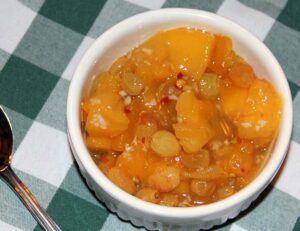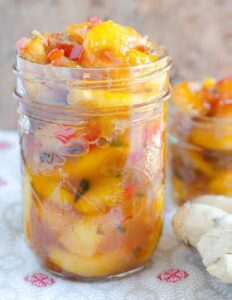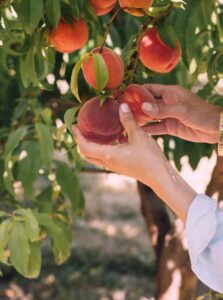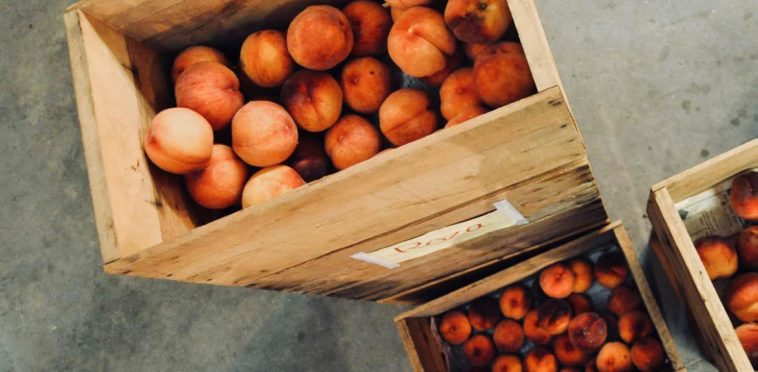Chutney is a sweet, tangy condiment that is served with curries, hot and cold meats and savouries.
Peach chutney may be prepared from both green and ripe peaches, along with other fruit/vegetables (for example onions, green peppers), sugar, vinegar and various spices and thickening agents. It is packaged in glass bottles and has a shelf life of several months at cool temperatures.
Formulation of peach chutney:
The formulation of peach chutney can vary according to taste.
The following is only a suggestion of the basic ingredients that can be used:
250 parts vinegar
500 – 750 parts chopped peaches
50 parts chopped onion
30 – 50 parts chopped green peppers
50 – 70 parts sugar
2,5 parts coriander
3 parts corn flour
2 parts salt
1 part turmeric
3 parts curry powder

Peach chutney. Photo: rikishore.com.
Preparation of ingredients for peach chutney
The peaches and other fruit/vegetables should be washed, free from pips and blemishes prior to being chopped by stainless steel knives, hand-driven apparatus or power-driven food choppers.
The size of the fruit pieces will have a great effect on the consistency of the end product. The fruit and all other ingredients are weighed or measured and placed in large boiling kettles. The purpose of boiling is to remove excess moisture, soften the fruit texture, develop flavour and cause destruction of moulds and yeast.
Cooking of peach chutney
The spices are added to the vinegar in a large saucepan or batch cooker and allowed to boil for 10 to 15 minutes. The remaining ingredients are added and slowly heated until all the sugar has dissolved. The heat is turned up to bring the mixture to boil and then left to simmer (uncovered) until the mixture starts to thicken (time varies from 40 to 200 minutes). Occasional stirring is required to prevent pieces from settling on the bottom and burning.

Filled glass jars. Photo: theforgot- co. tenteaspoon.files.wordpress.com.
Filling and sealing of jars with peach chutney
Chutney is filled into suitable containers at a temperature of 85 to 95 °C. This requires the boiling chutney to be slightly cooled in horizontally stirred mixers fitted with water jackets prior to filling. Suitable containers are common glass jars with lacquered metal screw-on tops.
Glass jars used for the preservation of food should be of high quality, without any cracks or chips, and should form tight seals. The bottles require proper cleaning and heating prior to filling to avoid cracking of the bottles (thermal shock) due to the high temperature of the chutney. Rotary fillers or multiple-piston displacement machines capable of filling between 100 and 600 jars per minute are used in large-scale operations. The jars are sealed immediately after filling using a steam-flow machine to ensure air exhaustion and the formation of a vacuum in the cooled, sealed product.
Cooling and drying of peach chutney containers
The product is cooled with water to approximately 40 °C to prevent excessive softening of the fruit and spoiling of the consistency of the product. This is done by either immersing the bottles in cold water or by passing the bottles through misting tunnels. In both cases, care must be taken not to give glass bottles a thermal shock by using too cold water, as this would result in cracking of the bottles. Counter-current water systems ensure that lukewarm water is used first, followed by progressively colder water.
The bottles are allowed to dry naturally or blow-dried prior to labelling.

Peaches on the tree.
Labelling of fruit preserves
The containers are labelled and coded so that the product contains all the necessary information. Products must be correctly labelled according to the requirements set out in your country’s regulations.
LITERATURE SOURCES
- Arthley, D. & Ashurts, P.R. (Ed) 1996. Fruit Processing: London: Blackie Academic & Professional.
- Fellows, P. 1988. Food Processing Technology – Principles and Practice. Chichester: Ellis Horwood, Ltd.
- Potter, N.N. & Hotchkiss, J.H. 1995: Food Science, 5th ed.: New York: Chapman & Hall.
- Raiken, M.D.; Kill, R.C. & Baker, C. (Ed). 1998. Food Industries Manual, 24th ed.: New York: Chapman & Hall.
- Salunke, D K, Bolin, H R & Reddy, N R. 1991: Storage, Processing, and Nutritional Quality of Fruits and Vegetables, 2nd ed. Volume II, Processed Fruits and Vegetables: Boca Raton: CRC Press
- Somogyi, L P, Ramaswamy, H S & Hui, Y H. 1996. Processing fruits – Science and Technology, Vol. 1 & 2: Lancaster: Technomic Publishing Co
- South Africa – Agricultural Products Standards Act (No 119 of 1990) and regulations. Pretoria: Government Printers
- South African – Foodstuffs, Cosmetics and Disinfectant Act (no 54 of 1972) and regulations. Johannesburg: Lex Patria
- Woodroof, J.G. & Luh, B.S. 1986. Commercial fruit processing, 2nd ed.: Connecticut: AVI Publishing









